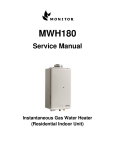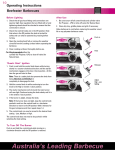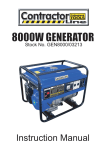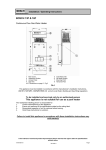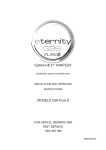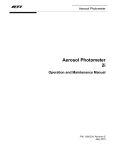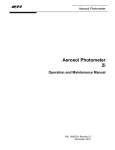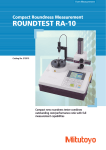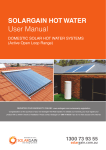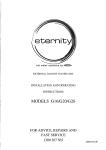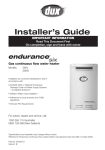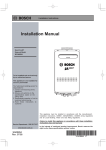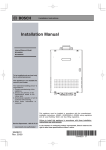Download INSTALLATION AND OPERATING INSTRUCTION
Transcript
INSTALLATION AND OPERATING
INSTRUCTION
INTERNAL GAS WATER HEATER
Model eternity I26
THIS HOT WATER UNIT IS NOT FOR POOL OR SPA HEATING
WARNING : If the information in this instruction is not followed exactly, a fire or
explosion may result causing property damage, personal injury or death.
- Do not store or use gasoline or other flammable vapours and liquids in the vicinity of this or
any other appliance.
- WHAT TO DO IF YOU SMELL GAS
• Do not try to light any appliance.
• Do not touch any electrical switch; do not use any phone in your building.
• Immediately call your gas supplier from a neighbor's phone.
Follow the gas supplier's instructions.
• If you cannot reach your gas supplier, call the fire department.
- Installation and service must be performed by a qualified installer, service agency or the
gas supplier.
INSTALLER : Leave this manual with the appliance.
CONSUMER : Retain this manual for future reference.
INDEX
SPECIFICATIONS ---------------------------------------------------------------------------- 1,2
PERFORMANCE ------------------------------------------------------------------------------ 2
FEATURES ------------------------------------------------------------------------------------- 3
FOR YOUR SAFETY READ BEFORE OPERATING -------------------------------- 4-10
ABOUT HOT WATER ------------------------------------------------------------------------ 11
SCALDS - FIRST AID ------------------------------------------------------------------------ 11
REMOTE CONTROLLER OPERATION ------------------------------------------------ 12,13
USE IN THE LIME-RICH WATER (HARD WATER) AREA ------------------------ 14
CAUTION ---------------------------------------------------------------------------------------- 15
PREVENTION OF FREEZING DAMAGE DURING WINTER SEASON -------- 16,17
FOR YOUR SAFETY READ BEFORE OPERATING -------------------------------- 18
OPERATING INSTRUCTIONS ------------------------------------------------------------ 19
DAILY INSPECTION AND MAINTENANCE ------------------------------------------- 20,21
IN CASE THE UNIT REMAINS UNUSED FOR A LONG TIME ------------------- 21
FAULT MONITOR ----------------------------------------------------------------------------- 22,23
TROUBLE SHOOTING AND SOLUTION ---------------------------------------------- 24
INSTALLATION INSTRUCTIONS -------------------------------------------------------- 25-28
DIMENSIONS ---------------------------------------------------------------------------------- 29
TEMPLATE OF L TERMINATION INSTALLATION ---------------------------------- 30
SUGGESTED PIPING-BASIC INSTALLATION --------------------------------------- 31
SUGGESTED PIPING-CIRCULATION SYSTEMS ----------------------------------- 32
VENT PIPE INSTALLATION --------------------------------------------------------------- 33-47
GAS PIPING ------------------------------------------------------------------------------------ 48
WATER PIPING-------------------------------------------------------------------------------- 48
ELECTRICAL CONNECTION ------------------------------------------------------------- 49
WIRING REMOTE CONTROLLER ------------------------------------------------------- 50
MAIN REMOTE CONTROLLER CMR-2251 ------------------------------------------- 51
BATH REMOTE CONTROLLER YST-2251/S ----------------------------------------- 52
TESTING OPERATION ---------------------------------------------------------------------- 53
WARRANTY ------------------------------------------------------------------------------------ 54
SPECIFICATIONS
Model number
eternity I26
Type of appliance
Gas continuous flow water heater
Approved gas type
Natural or Propane
Installation
Indoor only / Wall hanging
Set point temperature
(without remote)
Factory setting - 50ºC
Temperature range with remote
Remote controller : 37 - 75ºC
Exhaust system
Direct vent - forced combustion
Dimensions
Height 610mm
Width 350mm
Depth 210mm
Weight
20kg
Connections
Gas R3/4(20A)
Water inlet R3/4(20A)
Hot water outlet R3/4(20A)
Ignition system
Direct electronic ignition
Electrical consumption
Normal 62.3watts
Standby Main/Bath remote controller on 3.4watts
Recommended minimum water
supply pressure
150kPa
Maximum water supply pressure 1200kPa
Power supply
Appliance AC240V - 50Hz
Remote controller DC12V (digital)
-1-
SPECIFICATIONS
Flame failure - Flame rod
Over heat switch 100ºC
Over heat limit 95ºC
Safety devices
Thermal fuse 185ºC
Fan motor rpm check - PCB
Over current - Fuse (5 amp)
CMR-2251 Main control kitchen / laundry
Remote controller (option)
YST-2251/S Bathroom control / Ensuite
Remote controller cable (option)
Nonpolarized two core cable
Clearance from combustibles
Top of heater 30cm
Front of heater 15cm
Sides of heater 5cm
Back of heater 0cm
Floor 30cm
Vent pipe 0cm
PERFORMANCE
Gas consumption
Gas supply pressure
Mainfold gas pressure
MAXIMUM
MINIMUM
Natural Gas
55.6kW(200MJ)
6.0kW(22MJ)
Propane Gas
54.2kW(194MJ)
6.0kW(22MJ)
Natural Gas
1.13kPa
1.13kPa
Propane Gas
2.75kPa
2.75kPa
Natural Gas
0.60kPa
0.10kPa
Propane Gas
0.55kPa
0.10kPa
Hot water capacity
2.2-24.6L/min
Maximum hot water capacity (25ºC rise)
26L/min
-2-
FEATURES
eternity I26 is a new advanced technology water heater. It produces hot water, continuously.
For optimal performance, we recommend the use of the optional remote controllers.
eternity I26 will never run out of hot water. Hot water is available as long as a hot water faucet is
open.
As soon as a hot water faucet is opened, a signal goes to the microprocessor to start the burner
operation. Closing the faucet sends the shut down signal to stop the burner.
eternity I26 is furnished with an electronic ignition system.
This feature eliminates gas usage when no hot water is being used, leading to significant savings
in energy and money.
The advanced control system uses a sensor to continuously maintain the outgoing water
temperature.
The safety protections of the microprocessor include limiting the maximum temperature of the hot
water.
A fault monitor will display malfunction codes on the remote controllers. This simplifies trouble
shooting during service calls.
eternity I26 is designed to prevent varying temperature of hot water when the faucet is cycled on
and off. There is also a quick response mode for rapid heating.
The dimensions of eternity I26 use less wall space and no floor space.
The remote controllers are a crisp, modern design to blend in any decor.
Endless loop in input and output control ensures a stable flow of hot water.
Low NOx. The Rich - Lean design of the burner produces minimum nitrous oxides.
Greater reliability of electric components due to the coated control circuit board.
-3-
FOR YOUR SAFETY READ BEFORE OPERATING
For your safety and proper use of the unit.
Read and understand the following important symbols before use.
The cases shown below are classified by the degree of risk and damage.
Be sure to follow the instruction symbols for your safety.
Danger
"Danger" indicates that serious injuries or even death to the user may result
if the instruction is neglected and the unit is mishandled.
Warning
"Warning" indicates the possibility that serious injuries or even death to the
user may result if the instruction is neglected and the unit is mishandled.
Caution
"Caution" indicates the possibility that some injuries to the user, and/or
material damage may result if the instruction is neglected and the unit is
mishandled.
Each mark indicates:
General instruction
Electric shock
Fire
High temperature
Prohibited
No flammables
Do not touch
Do not disassemble.
Never fail to do.
Ground
-4-
FOR YOUR SAFETY READ BEFORE OPERATING
Danger
Disconnection of the vent pipes can cause a shortage of oxygen, fire, or overheating.
Check
Check to make sure the flue system is properly connected.
Leaking exhaust gas indoors poses a danger if the pipes are disconnected during operation.
Blockage in the vent pipes.
Check
Make sure the flue system is clear of any
blockage such as bird's nest, or debris such
as leaves, twigs or weeds.
The blockage may cause the leakage of the
exhaust gas indoors during operation,
which is dangerous.
In winter make sure snow does not block
the vent pipe.
Take necessary measures to prevent snow
drifts from blocking the outlet/inlet of the flue
pipe.
Check for gas leak. (May cause fire.)
Close
Close
If a gas leak is noticed, stop using the unit immediately and close the gas valve, then contact
your service person, or the gas supply company.
Do not light any appliance, disconnect the power plug or touch any electric switch.
No open flame
Prohibited
-5-
FOR YOUR SAFETY READ BEFORE OPERATING
Warning
Caution to prevent scalding.
Caution
Check the water temperature by hand first before using shower or stepping into the bath tub.
Do not change the temperature setting while others are running hot water.
Gush of hot water may cause scalding or cold water may cause discomfort.
Measures to be taken in case of emergency.
When there is an emergency such as earthquakes, hurricanes or fire follow these procedures.
1. Turn off the hot water faucet.
Turn off
2. Close the gas valve and the main water valve.
3. Turn off the main power.
Warning, in case of gas leakage, first close the gas
valve and wait for the leaked gas to disperse, then
turn off the main power supply.
Close
Close
4. Contact your service technician, or gas supplier.
Confirm type of gas and power supply.
(Wrong gas type may cause incomplete combustion, explosive ignition or fire.)
LPG
20437470
Natural Gas
20437480
WaterMark
AS3498 Lic W506
AS 4552
SAI Global
ETERNITY I 26 EXTERNAL GAS WATER HEATER
SAIG APPROVAL No.
GSCS20021
NAT.G
200
INPUT
MJ/h
45.6
OUTPUT
kW/h
0.60
TEST POINT PRESSURE HIGH
kPa
0.10
TEST POINT PRESSURE LOW
kPa
1.34/1.65
GAS INJECTORS
mm
20.0
WEIGHT
kg
1200
MAX. WATER PRESSURE
kPa
MIN. WATER PRESSURE
kPa
210
WATER HEATING CAPACITY 26L/min RAISED 25 ℃
VOLTAGE 240Volts-50Hz 0.47AMPS
SERIAL No.
-6-
20559480
DO NOT REMOVE
Make sure to use the correct gas type as
well as power supply (voltage/frequency)
as indicated on the RATING LABEL
located on the side, of the cabinet.
Natural Gas or Propane Gas are stated
on the GAS TYPE LABEL.
DO NOT REMOVE
Check
WaterMark
AS3498 Lic W506
AS 4552
SAI Global
ETERNITY I 26 EXTERNAL GAS WATER HEATER
SAIG APPROVAL No.
GSCS20021
LPG
194
INPUT
MJ/h
44.4
OUTPUT
kW/h
0.55
TEST POINT PRESSURE HIGH
kPa
0.10
TEST POINT PRESSURE LOW
kPa
1.0/1.2
GAS INJECTORS
mm
20.0
WEIGHT
kg
1200
MAX. WATER PRESSURE
kPa
MIN. WATER PRESSURE
kPa
210
WATER HEATING CAPACITY 26L/min RAISED 25 ℃
VOLTAGE 240Volts-50Hz 0.47AMPS
SERIAL No.
20559550
FOR YOUR SAFETY READ BEFORE OPERATING
Warning
Caution for flammable items.
(May cause fire or explosion.)
Warning
Disassembly, repair or modification of the
unit may cause fire, electric shock or other
accidents.
GASOLINE
Do Not Disassemble
Do not place any flammable items such as
gasoline, benzene, or spray cans near the
appliance.
Do not use them around the heater or the
exhaust vent terminal.
Take special care.
No installation outdoors or in the bathroom.
(May cause fire or electric shock or other
accidents.)
Do not disassemble or modify the units.
Never fail to ask for professional assistance
from your dealer for installation, removal,
auxiliary installation work, or connection to
solar units.
No rubber piping.
(May cause gas leakage or fire.)
Prohibited
The unit is for indoor installation use.
Never install outdoors or in the bathroom.
Steam from the shower or bath can cause
corrosion or malfunction.
Prohibited
Rubber pipe should never be used for gas
piping line.
-7-
FOR YOUR SAFETY READ BEFORE OPERATING
Caution
Be sure to electrically earth the unit.
Do not touch the exhaust vent pipe and
water heater during or immediately after
operation.
T!!
O
H
Ground
Do not touch
Do not use hair spray or spray detergent in
the vicinity.
Do not install in locations where excessive
dust or debris will be in the air.
Prohibited
Prohibited
Spray
Do not wipe remote controller with gasoline,
benzene, or detergents.
Do not turn off the water heater or change
the water temperature while someone is
bathing or washing. That may result in scalds
or burns.
Prohibited
Prohibited
-8-
FOR YOUR SAFETY READ BEFORE OPERATING
Caution
Confirm ignition, combustion and extinction.
Check
Do not allow the remote controller to get wet.
(May cause controller to fail.)
Flame logo indicator
Check
Always check Flame logo indicator for
combustion and that the unit has shut down
by checking the operation lamp on the Main
or Bath remote controller.
Do not install near electric appliances.
Measures to be taken for lightning possibility.
(May cause failure.)
Check
When installed near the TV or radio, it may
cause picture disturbance or sound
disturbance.
Provide adequate space around the unit for
service.
Temporary voltage surge caused by lightning
can damage the electronic parts.
Turn off the main power when you hear
thunder.
Use for approved applications only.
Check
Make sure to have enough room around the
unit to ensure space necessary for
checking and maintenance.
Check
Do not use the unit for other applications.
-9-
FOR YOUR SAFETY READ BEFORE OPERATING
Caution
Use only genuine factory designated parts,
and accessories.
Instruction in case the unit is used in
lime-rich water (hard water) area.
Check
Check
designated
part
Drain the residual hot water in the unit away.
Otherwise the lime may harden and deposit
in the pipe, causing lower efficiency and
damage to the unit. (refer to page 14)
eternity I26 is designed primarily for single
family home use.
Prohibited
Check
Notice:
If used in a commercial application, a limited
warranty applies.
Water or hot water left in the unit for a long
time is not suitable for drinking or cooking.
Do not drink or use for cooking.
- 10 -
ABOUT HOT WATER
Hot water heater temperature over 52ºC can cause severe burns instantly or death from scalding.
Children, disabled and elderly are at the highest risk of scalding.
Feel water temperature before bathing or showering.
Warning
HOT!!
BURN
SCALDS - FIRST AID
1. Remove clothing; Remove all wet clothing quickly. Wet clothing retains the heat.
2. Apply cold water for 30 minutes; Immediately submerge the burnt area in cold water for 30
minutes to reduce the heat in the skin, preventing deeper burning.
Never use butter, oils or ointment to cover the burn. They may retain the heat.
3. Keep the scalded person warm; Place a blanket around the person.
4. Seek medical advice; Call your medical advice hotline and describe the scald, follow their
directions.
- 11 -
REMOTE CONTROLLER OPERATION
CMR-2251
(Main remote controller)
This remote controller is intended to be used in the kitchen, laundry room or utility area.
Digital Monitor
Indicates the selected
water temperature.
Error messages flash in
the event of a failure.
ON Indicator
Indicates power is on to
the system.
Flame Logo Indicator
Indicates that a hot water
faucet is open and that
control of the temperature
is taken at another
controller.
ON/OFF Button
Power switch to operate
this control.
UP/DOWN Button
Increase or decrease the
desired water temperature.
PRIORITY Indicator
Indicates this controller
has priority control over
the other controller.
YST-2251/S
(Bath remote controller / Ensuite)
This remote controller is intended for installation in the bathroom.
Flame Logo Indicator
Indicates that a hot water
faucet is open and that
control of the temperature
is taken at another
controller.
PRIORITY Indicator
Indicates this controller
has priority control over
the other controller.
ON Indicator
Indicates power is on to
the system.
ON/OFF Button
Power switch to operate
this control.
Digital Monitor
Indicates the selected
water temperature.
Error messages flash in
the event of a failure.
UP/DOWN Button
Increase or decrease the
desired water temperature.
- 12 -
PRIORITY Button
Priority button to set the
water temperature on
Bath remote controller.
REMOTE CONTROLLER OPERATION
Operation of Main/Bath remote controller / Ensuite.
Please read these instructions carefully before using this appliance.
1. Turn on the ON/OFF button. (refer to page 12.)
2. The temperature display will illuminate at 42ºC.
3. The priority indicator will illuminate.
4. Select hot water temperature by pushing UP/DOWN button (
or
) on the controller.
5. Turn on the hot water faucet. Flame logo indicator will illuminate after a short delay.
This indicator will remain illuminated until the hot water faucet is turned off.
6. The hot water temperature can be altered at any time during the operation by pushing
or
UP/DOWN button (
) located on the controller.
or
PRIORITY control. (change.)
The temperature can only be controlled by the remote controller which has the priority indication.
Priority button is only located on the Bath remote controller / Ensuite.
When the priority switch is turned on, priority control over the water temperature is changed
voluntarily.
Warning
Do not turn off the water heater or change the water temperature while someone is bathing
or washing. That may result in scalds or burns.
• In case of installation of both a Main remote controller and a Bath remote controller / Ensuite
with priority button ON, when pushing priority button on Bath remote controller / Ensuite, the hot
water temperature will read 42ºC.
• In case of installation for Bath remote controller only, when pushing priority button on it, hot
water temperature will read 42ºC.
• The priority mode of YST2251/YST2251S can't accept ON/OFF during the operation.
It doesn't matter whether the operation is working or not.
Please operate it after closing the tap.
- 13 -
USE IN THE LIME-RICH WATER (HARD WATER) AREA
Caution
In case the unit is used in the lime-rich water (hard water) area, make sure to flush the
residual hot water away.
Otherwise lime may harden and deposit in the pipes causing low efficiency and damage to
the unit.
How to operate.
Perform the following steps after the hot water is used.
If control switch is not easily accessible :
Partially open the hot water faucet so that there is less than 1-2L/min flow until the cold water
starts to run.
2. Turn on the hot water faucet.
1. Turn the ON-OFF button off.
Turn on
Let the residual hot water completely run out.
3.
Turn off
Turn off the hot water faucet when the cold
water starts to run.
• Contact a qualified eternity service technician to remove lime once a year.
Failure to perform the annual maintenance will cause malfunction or damage to the heat
exchanger.
Damage caused by the lime build up is not covered by the unit's warranty.
If a “LC” code shows in the remote controller, call a technician to flush the system.
- 14 -
CAUTION
The residual water in the unit.
Do not drink or cook with any of the water left in the unit or in the pipe for a long time because the
quality may have deteriorated.
Power failure in winter.
Prevent freezing by following steps “ (2) By running water from any faucet. ” or
“ (3) By removing water in unit as freezing may cause damage to the unit. ”.
(refer to pages 16,17)
Resetting after power failure.
Note :
When not using the remote controller : Ensure that the hot water faucets are turned off.
The unit will automatically reset after power is restored.
When using remote controller(s) : If the remote controller was turned ON, when power is restored,
the remote controller will be ON, and the unit will automatically reset and deliver hot water on
demand.
If the remote controller has been shut OFF, it will remain OFF. After power is restored, and the
remote controller is turned back ON, the unit will be ready to use at the next demand for hot water.
If an error code appears before the power outage, the unit will remain OFF until the problem is
resolved.
In case damage is caused by natural disasters such as earthquakes
or hurricanes.
If gas or water leakage is suspected even though there is no apparent damage, shut off the Main
Gas valve, close the water valve, disconnect power supply, and check the extent of the damage.
Contact your local dealer for further assistance.
- 15 -
PREVENTION OF FREEZING DAMAGE DURING WINTER SEASON
Prevention of freezing.
The unit or pipe is likely to be damaged by freezing, not only in the cold latitudes, but also in the
mild-temperature zones in winter season. Pay careful attention to prevent freezing pipes.
(1) Anti-frost heater. (automatic.)
The power supply.
Caution
Make sure electrical power is supplied to the heater.
The following step 2. or 3. should be tried to avoid freezing.
(2) By running water from any faucet.
1. Close the main gas valve.
2. Turn on the hot water faucet.
Turn on
Close
About 4mm thick
Keep water running at about 400cc/min.
3. Turn off the main power.
Notice :
This helps prevent freezing of the pipes and the valves as well.
Check the flow volume 30 minutes after this procedure as the flow may fluctuate.
- 16 -
PREVENTION OF FREEZING DAMAGE DURING WINTER SEASON
(3) By removing water in unit as freezing may cause damage to the unit.
1. Close the main gas valve.
2. Close the main water supply valve.
Close
Close
3. Turn on the hot water faucet.
4. Remove the drain plug and the water
filter. (drain stopper.)
Turn on
Turn on a shower faucet if any.
5. Turn off the main power.
Notice :
This is the best method for protecting the unit.
Although, freeze prevention is not possible for the pipe and the valve.
When operation is resumed, put the water filter (drain stopper) back on and check if water
runs from the hot water faucet by turning on the main water supply valve.
- 17 -
FOR YOUR SAFETY READ BEFORE OPERATING
WARNING : If you do not follow this instruction exactly, a fire or explosion may result
causing property damage, personal injury or loss by fire.
A. This appliance does not have a pilot. It is equipped with an ignition device that automatically
lights the burner. Do not try to light the burner by hand.
B. BEFORE OPERATING : Smell all around the appliance area for gas. Be sure to smell next
to the floor because some gas is heavier than air and will settle on the floor.
WHAT TO DO IF YOU SMELL GAS
• Do not try to light any appliance.
• Do not touch any electric switch, do not use any phone in your building.
• Immediately call your gas supplier from a neighbor's phone. Follow the gas supplier's
instructions.
• If you cannot reach your gas supplier, call the fire department.
C. Use only your hand to turn the gas control knob. Never use tools. If the knob will not turn by
hand, do not try to repair it, call a qualified service technician. Force or attempted repair may
result in a fire or an explosion.
D. Do not use this appliance if any part has been under water. Immediately call a qualified
service technician to inspect the appliance and to replace any parts of the control system and
any gas control that has been under water.
- 18 -
OPERATING INSTRUCTIONS
1. Stop! Read the safety information mentioned previously before proceeding.
2. Turn off all electric power to the appliance.
3. This appliance does not have a pilot light. It is equipped with a direct ignition device that
automatically lights the burner. Do not try to light the burner by hand.
4. Turn the manual valve (installed on the gas supply line) clockwise
to the full OFF position.
Closed manual valve
("OFF" position)
Open manual valve
("ON" position)
5. Wait (5) minutes to clear out any gas. If you then smell gas, STOP! Follow "B" in the safety
information above on this manual. If you do not smell gas, go to next step.
6. Turn the manual valve (installed on the gas line) counterclockwise
to the full ON position.
7. Turn on all electric power to the appliance.
8. If the appliance will not operate, follow the instructions "TO TURN OFF GAS TO APPLIANCE"
and call your service technician or gas supplier.
TO TURN OFF GAS TO APPLIANCE.
1. Turn off all electric power to the appliance if service is to be performed.
2. Turn the manual valve (installed on the gas supply line) clockwise
- 19 -
to the full OFF position.
DAILY INSPECTION AND MAINTENANCE
Tips for the inspection.
Caution
Carry out the inspection and maintenance after the unit is shut down and cools off.
Turn the gas valve off and disconnect the power supply.
Pay full attention to any sharp edges on metal parts when doing inspection and
maintenance, as they may cause some injuries.
Never disassemble or modify the components.
Contact the service person when the unit does not work properly.
Inspection. (daily.)
Exhaust outlet, air intake and the
surrounding area.
GASOLINE
Make sure nothing obstructs the exhaust
outlet and air intake.
Make sure all clearances are maintained.
Make sure to keep the area surrounding the
unit and the exhaust outlet clear of any
combustibles and hazardous materials.
Gas leakage.
Water leakage.
Check if gas is leaking from the unit and the
Gas pipe.
Check if water is leaking from the unit or
the inlet or outlet pipes.
- 20 -
DAILY INSPECTION AND MAINTENANCE
Maintenance. (as required.)
Dust.
Cleaning the water filter. (drain stopper.)
Close
Close the main water supply, open a hot
water faucet to relieve any water pressure,
take the water filter (drain stopper) out, and
clean the filter element inside.
Wipe away dust and stains on the outside
surface of the unit with a damp cloth or
a sponge.
How to replace a component.
Contact the dealer when you need a component replaced.
Make sure to use only factory authorized part(s) for replacement.
CAUTION : Do not use the unit if it is not operating correctly.
This may result in explosion, gas leakage, or faulty combustion.
Contact the dealer or qualified service person when a repair is required.
Scheduled inspection.
An inspection is necessary for the unit after it has operated for a long period.
The annual inspection at least once a year is recommended.
IN CASE THE UNIT REMAINS UNUSED FOR A LONG TIME
Remove the water in the unit in accordance with Prevention of freezing “ (3) By removing water
in unit as freezing may cause damage to the unit ”(refer to page 17) in case the unit is not used
for a long time.
- 21 -
FAULT MONITOR
Fault monitor.
The eternity water heater has a self diagnosing function for faults.
When the unit does not operate correctly an error code is displayed on the Main and Bath remote
controllers digital monitor.
The cause of the fault can be determined after checking the fault numbers indicated on the remote
controller digital monitor.
Error Number
of
Code Flashes
000
001
Problem
Remedy
Check power failure.
-
Power recovery detection.
6
During power failure, remote controller
wiring is disconnected.
(Alarm record can be indicated in calling mode.)
Turn off the hot water faucets and turn
on again.
(Only applies when using remote controller before
power failure.)
(Alarm record can be indicated in calling mode.)
111
1
Gas burner fails to ignite.
Check gas supply.
121
3
Loss of combustion.
Check gas supply and pressure.
141
4
Over heat switch activated.
Call service center.
321
5
Outgoing thermistor wire breakage.
Call service center.
331
10
Heat exchanger thermistor wire breakage.
Call service center.
341
11
Air thermistor wire breakage.
Call service center.
611
7
Fan motor failure.
Call service center.
651
9
Water flow control device failure.
Call service center.
721
2
False flame detection.
Call service center.
740
750
-
After power on, nothing operates, but the
error code displays in 1 minute.
Call service center.
740
750
760
8
Communication failure between remote
controllers and PCB.
Turn off power and turn on again.
990
12
Air supply or exhaust blockage failure.
Check that nothing is blocking the air
intake or exhaust.
LC
-
Scale build-up (in heat exchanger) failure.
Call service center.
Flashing design of combustion indicator of PCB
A light on the PCB will flash 1 to 12 consecutive
times depending on the failure type.
A three second delay occurs between each set
of flashes.
Call an authorized service technician for trouble
shooting and repair.
Number of flashes of the combustion indicator
1 to 12 Flashes
1sec
- 22 -
Off
3sec
FAULT MONITOR
Alarm record monitor mode
Alarm record can be monitored by special operation of remote controller
1. Start up of alarm record calling mode.
While ON/OFF button is OFF, alarm record calling mode is obtained by simultaneously
pushing both UP/DOWN buttons ( and ) at Main or Bath remote controller for 5 consecutive
seconds.
• The ON indicator will flash while alarm record calling mode is ON.
2. Alarm record list indication method.
or
Alarm record can be monitored by pushing UP/DOWN button. (
)
Alarm occurrence order will match the following indication.
1 ---- Previous alarm (If present alarm is not reset, it shows present alarm.)
2 ---- Alarm 2 occurrences ago.
3 ---- Alarm 3 occurrences ago.
4 ---- Alarm 4 occurrences ago.
5 ---- Alarm 5 occurrences ago.
6 ---- Alarm 6 occurrences ago.
7 ---- Alarm 7 occurrences ago.
8 ---- Alarm 8 occurrences ago.
• If no alarm has been input, indicated by hyphen. (---)
3. Clearing alarm record.
During alarm record monitor mode, you can clear alarm record index, alarm record 1-8 and
combustion period during alarm by pushing ON/OFF button for 10 consecutive seconds.
• Clearing of compiled number of alarms shall not be done.
• In case the unit is relocated, be sure to use the above clearing procedure.
4. Completion of alarm record monitor mode.
• Alarm record monitor mode will be completed by simultaneously pushing both UP/DOWN
and
buttons (
) for 5 consecutive seconds.
• Alarm record monitor mode will be disengaged if no further operation is made for 5 consecutive
minutes while alarm record monitor mode is ON.
• Alarm record monitor mode will be disengaged if operation is resumed by other connected
remote controller.
- 23 -
TROUBLE SHOOTING AND SOLUTION
The following problems are not a malfunction or defect.
Check again before asking for servicing.
Problem
Explanation
Hard to ignite at the initial
attempts.
Air in the gas pipe. Shut the hot water supply faucet and
open. Repeat the process.
Hot water does not flow despite
the faucet being open.
Needs minimum water flow to ignite.
Turn the faucet further for more volume.
Hot water supply is discontinued
during the blackout and no
The unit will automatically reset as described on page 15.
recovery after the power is back
on.
Hot water with the desired
It takes a little time to reach the set temperature because
of the residual water in the pipe and of the distance
temperature is not available
instantly a faucet is turned open. between the unit and the faucet.
White steam comes out from the The exhaust gas contains a lot of vapor which turns white
exhaust outlet.
in contact with cold air.
Hot water looks white.
Air dissolved in the water and appears white.
The blower keeps running for a
while after the hot water faucet
is turned shut.
It continues to run for about 65 seconds to discharge the
exhaust gas in the combustion chamber.
Water temperature and flow
volume sometimes become
unsteady.
Water temperature and flow volume may fluctuate in case
hot water is used at other faucets at the same time or
water pressure changes occur or gas regulator fluctuations.
The surface of the remote
controller feels warm.
The remote controller itself feels warm because of the
display screen light, etc. Electronic circuit is activated even
when the switch of the remote controller is off. Heat is
generated.
Hot water flow volume
Hot water flow volume may fluctuate by the difference in
fluctuates, even in case of same
water supply temperature or water pressure fluctuations.
set temperature.
Temperature of the water at the
faucet may also vary from the
displayed temperature at the
remote controller.
Hot water temperature may vary from set temperature by
the climate, plumbing length or water flow.
- 24 -
INSTALLATION INSTRUCTIONS
• The cases shown below are classified by the degree of risk and damage.
Be sure to follow the instruction for your safety.
Danger
"Danger" indicates that serious injuries or even death may result from the
improper installation due to negligence of following the instructions.
Warning
"Warning" indicates the possibility that serious injuries or even death may
result from the improper installation due to negligence of following the
instructions.
Caution
"Caution" indicates the possibility that some injuries or material damage may
result from the improper installation due to negligence of following the
instructions.
Each mark indicates:
Prohibited
Never fail to do.
Ground
Danger
Never install the unit outdoors as it is exclusively for indoor use.
Do not install it in the bathroom. Electric shock or leakage may result.
INSTALLATION REQUIREMENTS
The eternity I26 must be installed in accordance
1. These instructions.
2. Uniform Building Regulations Local authority regulations;
3. AS/NZS 3500.4 National Plumbing and Drainage Code, Part 4 Hot Water Supply Systems,
4. The installation code AS5601 for gas burning appliances and equipment.
5. Any other statutory regulation that may apply.
6. A notice of intention to install shall be lodged with the relevant Municipal Authority and local
Gas Authority prior to installation.
INSTALLAION MUST BE CARRIED OUT ONLY BY AN AUTHORISED AND APPROPRIATE
LICENSED PERSON
- 25 -
INSTALLATION INSTRUCTIONS
Before installation.
Verification of the unit.
Warning
• Make sure the unit to be installed suits the intended use and application.
• Do not use any gas other than specified on the sticker.
• Do not operate with any power source (voltage/frequency) other than specified on the
sticker.
LPG
20437470
Natural Gas
WaterMark
AS3498 Lic W506
AS 4552
SAI Global
ETERNITY I 26 EXTERNAL GAS WATER HEATER
SAIG APPROVAL No.
GSCS20021
NAT.G
200
INPUT
MJ/h
45.6
OUTPUT
kW/h
0.60
TEST POINT PRESSURE HIGH
kPa
0.10
TEST POINT PRESSURE LOW
kPa
1.34/1.65
GAS INJECTORS
mm
20.0
WEIGHT
kg
1200
MAX. WATER PRESSURE
kPa
MIN. WATER PRESSURE
kPa
210
WATER HEATING CAPACITY 26L/min RAISED 25 ℃
VOLTAGE 240Volts-50Hz 0.47AMPS
SERIAL No.
20559480
DO NOT REMOVE
DO NOT REMOVE
20437480
WaterMark
AS3498 Lic W506
AS 4552
SAI Global
ETERNITY I 26 EXTERNAL GAS WATER HEATER
SAIG APPROVAL No.
GSCS20021
LPG
194
INPUT
MJ/h
44.4
OUTPUT
kW/h
0.55
TEST POINT PRESSURE HIGH
kPa
0.10
TEST POINT PRESSURE LOW
kPa
1.0/1.2
GAS INJECTORS
mm
20.0
WEIGHT
kg
1200
MAX. WATER PRESSURE
kPa
MIN. WATER PRESSURE
kPa
210
WATER HEATING CAPACITY 26L/min RAISED 25 ℃
VOLTAGE 240Volts-50Hz 0.47AMPS
SERIAL No.
20559550
Location of the unit.
Decide where to install the unit by considering customer’s request and venting length
limitations.
Warning
Ventilation
• Install the unit where there is enough space for ventilation.
• Use the designated vent terminal (option).
• Make sure the pipe termination is kept clear of snow.
• Check for the holes, cracks, blockage, or gap in connections of the piping.
Reuse the components only after making sure there is no problem.
• Do not install the unit where flammables such as gasoline, benzene, and adhesive are
handled.
- 26 -
INSTALLATION INSTRUCTIONS
Installation.
Caution
• Reinforce the wall if necessary as this unit weighs about 20kg.
• Make sure that there is adequate floor drainage to prevent flooding the floor.
1. Twist 1 screw (for wall hanging) into the wall leaving about 4mm length to hook on.
2. Hook the center hole of the wall hanging bracket onto the screw and securely fix the unit
with 4 screws.
3. Adjust the clearance between the unit and the wall by loosening 8 hexagon head screws
(upper and lower) and then securely fix the unit, so it is level.
Screw
(for wall hanging)
About
4mm
Wall hanging bracket
618mm
Screw
(for wall hanging)
Screw
(for wall hanging)
Screw
(for wall hanging)
Screw
(for wall hanging)
Wall hanging bracket
- 27 -
Hexagon
head screw
INSTALLATION INSTRUCTIONS
Caution
• Check if adjacent wall or ceiling is fire resistant and allows safe distance for fire prevention.
• This water heater is suitable for residential water (potable) heating only. Do not use this
water heater for space heating, combination space heating/domestic water heating, or
commercial water heating applications.
• eternity I26 is not suitable for use in pool or spa applications.
• Maintain proper space around the unit for proper servicing and operation. Minimum
clearances from combustible materials are listed below.
Top of heater
Back of heater
Front of heater
Sides of heater
Floor
Vent pipe
30cm
0cm
15cm
5cm
30cm
0cm
• Secure enough space so that the inspection and repairs can be done easily.
• Secure space not only in front but also under the unit.
• Install the vent terminal in a place where sufficient ventilation can be secured.
• This unit is designed to be installed indoors using the proper vent piping to exhaust
by-products of combustion to the outside environment.
Contact your dealer or eternity for proper vent kits.
• Do not install the unit over other combustion appliances.
Oil residue and dust in the air can adhere to the burner and the heat exchanger resulting in
deformation, loss of efficiency, or damage to electronic components.
• Do not install the vent terminal near the outlets of the other appliances.
Install the air intake terminal away from the wind path as the wind may cause imperfect
combustion.
• Keep the vent terminal away from the wall or the overhangs as far as possible even if it is
noncombustible in order to prevent discoloration and staining caused by the exhaust gas.
• Do not install the unit where commercial chemicals are used.
Those chemicals are ammonia, sulfur, chloride, ethylene compound and acids which are
used at beauty shop, laundry, factory and so forth.
• Do not install the unit over food or dishes.
• Pipe pressure relief to a drain or outside environment, or within 100mm of the floor.
Pipe pressure relief discharge to a drain or outside environment. (refer to page 50)
• The appliance should be located in an area where leakage from the unit or connections will
not result in damage to the area adjacent to the appliance or to lower floors of the
structure. When such locations can not be avoided, it is recommended that a suitable drain
pan, adequately drained, be installed under the appliance. The pan must not restrict
combustion airflow.
- 28 -
110mm
10~46mm
DIMENSIONS
ø79mm
610mm
580mm
168mm
50mm
97mm
113.5mm
- 29 -
103mm
33.5mm
97mm
210mm
92mm
623mm
ø127mm
67mm
350mm
TEMPLATE OF L TERMINATION INSTALLATION
Thickness
(refer to TABLE)
Facing plate
Holes
(refer to TABLE)
L termination
468mm
Facing plate
Reducer
168mm
623mm
84mm
50mm
TABLE : Relationship between the range of wall thickness and the diameter of opening on the wall.
Model Number
P/N
the range of wall thickness
the diameter of opening
3810
100-250mm
ø144-150mm
FFT-7U-200
3811
250-450mm
ø147-150mm
FFT-7U-300
3812
450-650mm
ø154-175mm
FFT-7U-500
3813
100-250mm
ø144-150mm
FFT-7U(L)-200
3814
250-450mm
ø147-150mm
FFT-7U(L)-300
3815
450-650mm
ø154-175mm
FFT-7U(L)-500
*The diameter of the wall opening does not need to be increased if the wall opening is pitched
DOWNWARD towards the outside at a 2º pitch.
- 30 -
SUGGESTED PIPING-BASIC INSTALLATION
This drawing is intended only as a guide.
It does not imply compliance with local building codes.
Installation must be done in accordance with local building
codes and may vary depending on installation location.
Confer with local building officials before installation.
Union
Union
Union
Shut off valve
Valve 1 Valve 2
Pressure relief valve
Minimum R3/4
Gas supply
Drain
Valve 3
Valve 4
Minimum R3/4
Hot water supply line
Minimum R3/4
Cold water supply line
- 31 -
SUGGESTED PIPING-CIRCULATION SYSTEMS
This drawing is intended only as a guide.
It does not imply compliance with local building codes.
Installation must be done in accordance with local building
codes and may vary depending on installation location.
Confer with local building officials before installation.
Union
Union
Union
Shut off valve
Valve 1 Valve 2
Pressure relief valve
Minimum R3/4
Gas supply
Drain
Valve 3
Valve 4
Minimum R3/4
Hot water supply line
Minimum R3/4
Cold water supply line
Union
Check valve
Hot water return
Storage tank
Pump Check valve
Fixtures
- 32 -
VENT PIPE INSTALLATION
Vent5601
AS
Terminal
CLEARANCE
Clearances.
REQUIREMENTS.
Openable
window
a
T
h
j
n
f
c
I
j
h
j
k
Ref.
M
P
d
P
d
T
g
See note2
LEGEND:
T Flue terminal
I Mechanical air inlet
e
h
Door
k
c
e
Gas meter
Electricity meter or fuse box
g
T
M
b
See note3
Shading indicates prohibited
areas for flue terminals
Minimum clearances
(mm)
Natural
Fan
draft
assisted
Item
a
Below eaves, balconies and other projections:
Appliances up to 50MJ/h input
300
200
Appliances over 50MJ/h input
500
300
b
From the ground, above a balcony or other surface
300
300
c
From a return wall or external corner
500
300
d
From a gas meter(M) (see 4.7.11 for vent terminal location of regulator)
1000
1000
e
From an electricity meter or fuse box (P)
500
500
f
From a drain pipe or soil pipe
150
75
g
Horizontally from any building structure or obstruction facing a terminal
500
500
h
From any other flue terminal, cowl, or combustion air intake
500
300
j
Horizontally from an openable window, door, non-mechanical air inlet, or any other opening into a building with the
exception of sub-floor ventilation:
Appliances up to 150MJ/h input
500
300
Appliances over 150MJ/h input up to 200MJ/h input
1500
300
Appliances over 200MJ/h input up to 250MJ/h input
1500
500
Appliances over 250MJ/h input
1500
1500
All fan-assisted flue appliances, in the direction of discharge
1500
k
From a mechanical air inlet, including a spa blower
1500
1000
n
Vertically below an openable window, non-mechanical air inlet, or any other opening into a building with the exception
of sub-floor ventilatin:
Space heaters up to 50MJ/h input
150
150
Other appliances up to 50MJ/h input
500
500
Appliances over 50MJ/h input and up to 150MJ/h input
1000
1000
Appliances over 150MJ/h input
1500
1500
Unless appliance is certified for closer installation
NOTES:
1 All distances are measured to the nearest part of the terminal.
2 Prohibited area below electricity meter or fuse box extends to ground level.
3 See Clause 5.13.6.6 for restrictions on a flue terminal under a covered area.
4 See Appendix J, Figures J2(a) and J3(a), for clearances required from a flue terminal to an LP Gas cylinder, A flue terminal
is considered to be a source of ignition.
5 For appliances not addressed above acceptance should be obtained from the technical regulator
FIGURE 5.3(in part) MINI MUM CLEARANCES REQUIRED FOR BALANCED FLUE TERMINALS, FAN-ASSISTED FLUE TER
MINALS, ROOM-SEALED
APPLIANCE
TERMINALS
OR THE
TERMINALS
OF OUTDOOR APPLIANCES
Note
: Check
local codes
and
ordinances.
- 33 -
VENT PIPE INSTALLATION
• Use only designated vent terminal (sold separately).
• Install correctly in accordance with the installation manual attached.
• Select the correct switch position depending on the length of the vent pipe.
• Make sure that the proper distance, within the limitations, is determined between the unit and the
termination of the vent pipe.
• Make sure the terminal of the vent pipe terminates outdoors.
• Prevent the exhaust gas from flowing back indoors through the gap between the termination and
the wall where the vent pipe penetrates.
• Make sure snow drift will not block the vent terminal when it has been piled or fallen.
• Do not place hazardous materials near the end of the vent termination.
• Make sure to install the vent terminal at downward slope to prevent rain from entering inside.
• Some vapor or condensation may be generated from the vent terminal.
• Place the vent terminal where it is not affected by water splashing or falling off the roof eaves.
• A vent system that exits the structure through a sidewall shall terminate not less than 30cm
above the ground.
Check local codes and ordinances which may require higher clearances.
• The termination of the vent system shall not be located in public traffic areas, such as walkways,
unless the vent system is at least 2m above the ground.
• Terminate the system 2m from the combustion air intake of any appliance.
• Place the system at least 1m away from any other building opening, gas utility meter, service
regulator or the like, or less distance if specified in the appliance's instructions.
Ensure that positioning of the vent system complies with the requirements of AS 5601
- 34 -
VENT PIPE INSTALLATION
• In case extension of the vent pipe is required, it shall be limited to the maximum of 12.5m
based on the formula below.
However, the maximum height of the vent pipe is limited to 1.5m.
• Calculate D (distance) value according to the length of the vent pipe and the number of elbows.
D = L + (M90 X 2) + (M45 X 0.5)
D : Distance
L : Total extended length of straight vent pipe and adjustable vent pipe.
M 90: Number of 90º elbow
M 45: Number of 45º elbow
Note : Maximum number of M90 is 3pcs.
Maximum number of M45 is 5pcs.
In case of combination use for M90 and M45, maximum total number is 5pcs.
To prevent the vent/air intake piping from occurring condensation, the fan has following 4 type
settings with 2 dip swiches, No.7 & No.8 in each D value.
Both dip switch No.7 & No.8 ON is factory setting ; this is suitable for over 9 in D value.
• Depending upon the vent length, dip switch No.7 & No.8 on PCB may need to be adjusted to
compensate fan speed. Read the following instructions to determine which position this switch
should be placed in.
• In case D value is 9 and above, leave dip switch No.7 & No.8 (ON).
• In case D value is 6 and above, but less than 9, set dip switch No.7 OFF and leave dip switch
No.8 (ON).
• In case D value is 4 and above, but less than 6, leave dip switch No.7 (ON) and set dip switch
No.8 OFF.
• In case D value is less than 4, set both dip switch No.7 & No.8 OFF.
(Factory setting No.7 & No.8 ON.)
< Dip switch on PCB >
L termination
Reducer
< Dip switch on PCB >
1 2 3 4 5 6 7 8
OFF
1 2 3 4 5 6 7 8
OFF
* No.1 dip switch is
ON with Natural
Gas and OFF with
Propane Gas.
• Example #1 :
In case of L termination and reducer.
(Refer to Fig. 4-1 page 42)
D = 0 + (0x2) + (0x0.5) = 0
- 35 -
VENT PIPE INSTALLATION
Note :
• In case D value is longer than 12.5, the unit shall be relocated with vent length of less than 12.5m.
• In case vent pipe requires extension, use coaxial vent pipe and elbows and start from the vent
terminal side.
• Install the vent pipe at slight decline toward the vent terminal. (refer to page 42)
• Install the vent pipe securely by using sling fittings to support the connected parts.
• Use fittings at 1.5m intervals. Do not use wire.
• When installing extended vent pipe :
Take special precaution to stay clear of combustible surfaces.
• In case of horizontal direct vent installation, be sure to use recommended vent terminal.
• In case of horizontal direct vent installation with recommended vent terminal, connect reducer
between water heater and vent terminal.
• In case of other horizontal direct vent installation, connect reducer between pipe and vent
terminal.
Warning :
• Failure to follow the installation instructions could cause FIRE, CARBON MONOXIDE
POISONING, or DEATH.
• Never change the position of any dip switch other than No.7 & No.8.
• Unauthorized alteration and use of the unit in a wrong setting may cause material damage,
injury accident, scalding, or even death.
• Exceeding the maximum vent length is dangerous and may result in bad combustion.
• Be sure to connect the vent pipes in such a way so that no exhaust gas leaks when they are
installed in a concealed area, such as the attic.
Caution :
• The edges of sheet metal parts may be sharp.
Always wear gloves and appropriate eye, foot, and other protections when handling these
products.
• It is recommended that experienced professionals familiar with the operation and maintenance
of heating appliances and vent / air intake system install this system.
These instructions are a guide to assist a professional installer.
• Before commencing installation, please read the installation instructions carefully.
• Failure to follow the installation instructions could cause not only the lower performance of
appliance but also property damage or personal injury.
• Different manufactures have different joint systems and adhesives.
Do not mix pipe, fitting, or joining methods from different manufacturers.
• Examine all components for shipping damage prior to installation.
- 36 -
VENT PIPE INSTALLATION
General installation requirements.
(1) Selecting installation site.
• A vent system that exits the structure through a sidewall or the like shall terminate not less
than 30.5cm above the ground.
• The termination of the vent system shall be located above the snow line in geographical
areas where snow accumulates.
• The termination of the vent system shall not be located in public traffic areas, such as
walkways, unless the vent system is at least 2.13m above the ground.
Ensure that positioning of the vent system complies with the requirements of AS5601
Check local codes and ordinances which may require higher clearances.
(2) Clearance to combustibles and openings
Maintain clearances to openings as follows
• Terminate the system 1.8m from the combustion air intake of any appliance.
• Place the system at least 0.9m away from any other building opening, gas utility meter,
service regulator or the like, or less distance if specified in the appliance's instructions.
Items of vent system.
Items shown below in TABLE 1 are used for this vent system. The diameters of pipes are 79mm
for inner vent pipe and 127mm for outer air intake pipe. The length of the items are shown in Fig. 1
TABLE 1 : Items
Connection
and
detachment
Fig. 2
(page 39)
Vent length *
Fig. 2
Fig. 2
Fig. 2
Fig. 2
Vent termination
Fig. 3
(page 40)
Others
Fig. 2,3
Length 300mm
Length 600mm
Straight
Length 900mm
Adjustable Length 175-230mm
Adjustable
Adjustable Length 215-310mm
45º elbow
Elbow
90º elbow
Male-male Adapter
Straight Termination
Horizontal L Termination
Reducer
Air Intake Pipe
Vertical
Rain Cap
Support Strap
Support
(150cm clearance)
Base
Cap
Roof
Roof Flashing
Members
Adapter A
Adapter B
- 37 -
Model
Number
FFTP300
FFTP600
FFTP900
FFTA200
FFTA260
FFTEL45
FFTEL90
FFTMM
FFT7U
FFT7U(L)
FFTRD
FFTAIP
FFTRT
FFTSTR
FFTRFB
FFTRFC
FFTRFAA
FFTRFAB
P/N
3801
3802
3803
3804
3805
3806
3807
3808
Refer to
TABLE 2
(page 43)
3816
3817
3818
3819
3820
3821
3822
VENT PIPE INSTALLATION
Straight Length
Rain Cap
Adjustable Length
128
201.5
L
300mm
600mm
900mm
90º elbow
Model Number
FFTA200
FFTA260
45º elbow
P/N
3804
3805
L
175-230mm
215-310mm
79
Male-male Adapter
153
50
Air Intake Pipe
55
125
50
505
P/N
3801
3802
3803
L
270
Model Number
FFTP300
FFTP600
FFTP900
50
40
L
0.15
70
135
205
50
127
50 40 50
Support Strap
196
127.6
80
79
120.4
470
Reducer
167
112.2
78.8
75
120
133.6
120
L2=305 or 365
L1
79.4
Straight Termination (Refer to TABLE 2 page 43)
FFT-7U
112.2
133.6
L Termination (Refer to TABLE 2 page 43)
FFT-7U(L)
L1 : Refer to TABLE 2 (page 43)
Roof Flashing (adapter)
L1
78.8
L1 : Refer to TABLE 2 (page 43)
Roof Flashing (base)
Roof Flashing (cap)
L1
660
L2
75
278
Model Number
FFTRFAA
FFTRFAB
P/N
3821
3822
L1
440mm
440mm
L2
205mm
369mm
L3
643mm
738mm
60
L3
20º
40º
< Fig. 1 The dimensions of items >
- 38 -
128.6
(unit : mm)
VENT PIPE INSTALLATION
All the air used for combustion shall be supplied from the outside and all the exhaust gas shall be
discharged to the outside.
The minimum and maximum wall thickness required for installation:
Minimum 10cm
Maximum 65cm
The procedure of installation.
(1) Common procedure for vertical and horizontal installation.
• Joint connection and detachment method
Items in TABLE 1 shall be connected and detached by one of the following method (a),(b).
The column, Connection and detachment, in TABLE 1, page 37. indicates which method should
be used. Vent pieces should not be cut.
(a) Mainly, method (a) is used for connection and detachment. It’s for Horizontal terminations
(straight termination and L termination), vent lengths, drain tee, and reducer.
Slide piece
Into cover
Stopper bead
Stopper bead
Female end
Male end
Insert the male end fully into the female end until the
stopper bead is seated against the stop end on the
female end.
Then pull out female end, holding the slide piece in, until
the slide piece is clear of the stopper bead.
Confirm female/male ends of the lengths.
A female end has slide piece.
Slide piece
Stopper bead
Female end
Female end
Male end
Male end
Insert the male end fully into the female end until the
stopper bead is seated against the stop end on the
female end.
Pull up the female end with slide piece kept in the
stopper cover.
Connection
Disconnection
< Fig. 2 Joint connection and detachment method (a), (b) >
- 39 -
VENT PIPE INSTALLATION
(b) Rain cap, air intake pipe, and roof flashing (cap) shall be connected by turning the screw at
each end of pipes clockwise as far as they will go, as shown in Fig. 3.
When connecting between air intake pipe and roof flashing (cap), confirm that the end of air
intake pipe reaches the outer bead of roof flashing (cap) because the screw section is hidden
in outer pipe.
When disconnecting them turn counterclockwise.
Rain cap
Female screw
Turn
clockwise
Male screw
Air intake pipe
Female screw
Turn
clockwise
Roof flashing
(cap)
Male screw
Turn clockwise till the end
of air intake pipe reaches
the outer bead of roof
flashing (cap)
< Fig. 3 Joint connection and detachment method (b) >
- 40 -
VENT PIPE INSTALLATION
• Adjustable lengths
Adjustable lengths are available to allow for installation where fixed-length sections do not
produce the desired dimensions. Also adjustable lengths may be used to compensate for
linear thermal expansion/contract between two fixed points.
As shown in Table1, 2 types of adjustable lengths are available according to the limits in which
its effective length can be made longer and shorter.
• Elbows
45º and 90º elbow are available for changing the direction of the vent system.
The flexible section of each can be bent by hand for making small angle adjustment.
Do not bend repeatedly or extremely, because it may cause vent gas leaks.
• Support
Support the vent system every 1.5m.
1) Secure the support to solid material using the screws provided with the support.
2) Loosen the nuts of the cylinder.
After inserting pipes, fasten the loosened nuts.
Use the pairs of nuts and bolts provided with the support.
- 41 -
VENT PIPE INSTALLATION
(2) Detail of installation.
No less than 2º
No less than 2º
L termination
Reducer
Fig. 4-1
Horizontal installation [FFT-7U(L)]
Fig. 4-3
Horizontal extended installation
No less than 2º
Straight termination
Reducer
Male end
90º elbow
Female end
Fig. 4-2
Horizontal installation [FFT-7U]
• Horizontal installation.
Horizontal installation can consist of only horizontal termination (straight termination or
L termination), reducer, and 90º elbow. If the distance between an inner wall and the center of
the appliance flue outlet is under 146mm, use L termination [FFT-7U(L)] and reducer as shown
in Fig. 4-1. Otherwise, use straight termination [FFT-7U] and reducer as shown in Fig. 4-2.
A continuously DOWNWARD slope of no less than 2º is maintained in the horizontal portion.
• Horizontal extended installation.
Horizontal extended installation means installation on an internal wall apart from the appliance.
It can consist of straight termination, reducer, straight lengths, adjustable lengths, and elbows
as shown in Fig. 4-3.
A continuously DOWNWARD slope of no less than 2º is maintained in the horizontal portion
toward the outside.
- 42 -
VENT PIPE INSTALLATION
TABLE 2 : Relationship between the range of wall thickness and the diameter of opening on the wall.
Model Number
the diameter of opening
the range of wall thickness
P/N
ø144-150mm
100-250mm
3810
FFT-7U-200
250-450mm
ø147-150mm
3811
FFT-7U-300
450-650mm
3812
ø154-175mm
FFT-7U-500
100-250mm
3813
ø144-150mm
FFT-7U(L)-200
250-450mm
3814
ø147-150mm
FFT-7U(L)-300
450-650mm
3815
FFT-7U(L)-500
ø154-175mm
*The diameter of the wall opening does not need to be increased if the wall opening is pitched
DOWNWARD towards the outside at a 2º pitch.
Horizontal installation (See Fig. 5).
The horizontal termination (straight termination and L termination) consists of two parts (sleeve
and termination itself).
Separate them before installation.
1. Check the location of appliance and the path for the vent system.
2. Check wall thickness where the vent system passes through, and select suitable horizontal
termination according to TABLE 2. Cut the opening for the sleeve with the diameter in TABLE 2.
(Cover the flue outlet to avoid debris from entering the appliance)
3. Adjust the length of the sleeve so that the end of the sleeve protrudes about 5mm from the wall.
Then fasten the sleeve with the screw provided.
*Remember a stamped letter on the sleeve.
4. When the opening is too large, twist the packing provided around the end of the sleeve after
peeling off backing paper from the packing.
5. Insert the sleeve to the wall and fasten with 4 screws provided. Use plugs provided if needed.
*Ensure the UP label on sleeve plate is at the top.
*If it isn't easy to insert the sleeve because the packing doesn't fit the wall, press down the
packing during insertion.
6. Seal between the end of the sleeve and wall, and between the end of inner sleeve pipe and
outer pipe.
7. Adjust the length of the termination by fastening it at the stamped number same as that in 2.
8. Fasten the condensation prevention plate with the screw provided.
(In case of L termination or straight termination with reducer and elbow without additional straight
length, this plate must be installed.)
9. Insert the termination into the sleeve from inside wall so that 4 studs on sleeve plate are
inserted into each 4 holes on termination plate and fasten the termination to the sleeve with the
4 nuts provided.
*Ensure that the label on the termination is at the top.
10. Ensure that the end of air intake pipe protrudes about 10mm from the sleeve.
11. If using straight termination, connect reducer on appliance flue outlet, and 90º elbow between
reducer and termination.
If using L termination, connect reducer on appliance flue outlet and slide the adjustable part or
the termination to fit it to the flue outlet.
Make sure that a continuously DOWNWARD slope of no less than 2º is maintained in the
horizontal portion.
Refer to Fig 4-1 & 4-2 page 42.
12. Attach facing plate for outer wall as required.
*Drill 3 pilot holes in the outer wall first. Then insert plugs to the holes and fasten the facing plate
to the wall with 3 screws provided. Locate the notch of the facing plate at the bottom of the plate.
*Seal between the facing plate and the wall. Do not seal the notch.
- 43 -
VENT PIPE INSTALLATION
3.
10.
Stamped letter
End of air intake pipe
About
0.5cm
End of sleeve
Sleeve
Packing
4.
11.
UP
No less than 2º
L termination
Plug
5.
Reducer
4 Screws
UP
6.
Seal between
sleeve and wall
Horizontal installation [FFT-7U(L)]
Seal between
inner sleeve pipe
and outer pipe
Seal between
sleeve and wall
No less than 2º
Straight termination
7.
Reducer
90º elbow
Stamped letter
Termination
8.
Condensation prevention
plate
Horizontal installation [FFT-7U]
Screw M4 X 10
9.
UP
12.
3 Plugs
Label
3 Screws
4 Nuts
Facing plate
< Fig. 5 Detail of horizontal installation >
- 44 -
Notch
VENT PIPE INSTALLATION
Maximum vent length
Number of 90º elbow Maximum vent length
3
7.0m
8.8m
2
10.7m
1
Horizontal extended installation (See Fig. 6).
The straight termination consists of 2 parts (sleeve and termination itself). Separate them before
installation.
1. Check the location of appliance and the path for the vent system. And calculate the required
number and combination of items (see the dimensions of items in Fig.1).
2. Check wall thickness where the vent system passes through, and select suitable horizontal
termination according to TABLE 2. Cut the opening for the sleeve with the diameter in TABLE 2.
(Cover the flue outlet to avoid debris from entering the appliance)
3. Adjust the length of the sleeve so that the end of the sleeve protrudes about 5mm from the wall.
Then fasten the sleeve with the screw provided.
*Remember a stamped letter on the sleeve.
4. When the opening is too large, twist the packing provided around the end of the sleeve after
peeling off backing paper from the packing.
5. Insert the sleeve to the wall and fasten with 4 screws provided. Use plugs provided if needed.
*Ensure the UP label on sleeve plate is at the top.
*If it isn't easy to insert the sleeve because the packing doesn't fit the wall, press down the packing
during insertion.
6. Seal between the end of the sleeve and wall, and between the end of inner sleeve pipe and
outer pipe.
7. Adjust the length of the termination by fastening it at the stamped number same as that in 2.
8. Fasten the condensation prevention plate with the screw provided if this plate is needed.
9. Insert the termination into the sleeve from inside wall so that 4 studs on sleeve plate are
inserted into each 4 holes on termination plate and fasten the termination to the sleeve with the
4 nuts provided.
*Ensure that the label on the termination is at the top.
10. Ensure that the end of air Intake pipe protrudes about 10mm from the sleeve.
11. Support the vent system every 1.5m with support straps.
12. Attach facing plate for outer wall as required.
*Drill 3 pilot holes in the outer wall first. Then insert plugs to the holes and fasten the facing plate
to the wall with 3 screws provided. Locate the notch of the facing plate at the bottom of the plate.
*Seal between the facing plate and the wall. Do not seal the notch.
- 45 -
VENT PIPE INSTALLATION
3.
9.
UP
Stamped letter
Label
About
0.5cm
4 Nuts
Sleeve
4.
10.
Packing
End of air intake pipe
UP
End of sleeve
5.
11.
Plug
4 Screws
No less than 2º
UP
1.5m
Reducer
90º elbow
Support strap
6.
Seal between
sleeve and wall
Straight length
Seal between
inner sleeve pipe
and outer pipe
Straight termination
Seal between
sleeve and wall
7.
Horizontal extended installation without drain tee
Stamped letter
Termination
8.
12.
3 Plugs
3 Screws
Condensation prevention
plate
Facing plate
Screw M4 X 10
< Fig. 6 Detail of horizontal extended installation >
- 46 -
Notch
VENT PIPE INSTALLATION
Vertical installation.
1. Vertical installation means installation of vent terminal on flat or angled roofs. It consists of
rain cap, reducer, straight lengths, adjustable lengths, and elbows.
2. It shall be limited to the maximum height 1.5m.
3. Check the location of appliance and the path for the vent system. And calculate the required
number and combination of items (see the dimensions of items in Fig.1, page 38) of the vent
system. Check the pitch of roof where the vent system passes through.
4. Cut 135mm diameter openings(or suitable 'oval' for pitched roof) in each floor, ceiling, and the
roof where the vent system passes through.
5. Install the vent system from the appliance to roof by using straight lengths, adjustable lengths,
and elbows.
Make sure that a continuously UPWARD slope of no less than 2º is maintained in the horizontal
portion.
6. Support the vent system every 1.5m with support straps.
7. Once the vent system reaches under the roof, set the parts of roof flashing. The parts required
and the connecting order of them depend on the pitch of the roof shown in Fig. 7.
8. Fasten the bottom part of roof flashing (cap) or (adapter) to roof with screws, nails or so on.
If the 4 holes at the 4 corners of the part is larger than screws or nails, insert the 4 washers
provided with the part.
9. If roof flashing (adapter) is used, connect roof flashing (base) to roof flashing (adapter) with the
bolts provided with the part.
10. Connect the pipe of roof flashing (cap) to vent system.
Adjust the angle of roof flashing (cap) so as to make the pipe of roof flashing (cap) vertical.
11. Seal between the parts of roof flashing and roof.
The pitch of the roof ; 20º-40º
Rain cap
Air intake pipe
Roof flashing (cap)
Roof flashing (base)
Roof flashing (adapter A)
The procedure of installation
The pitch of the roof ; 40º-55º
The pitch of the roof ; 20º or less
Rain cap
Rain cap
Air intake pipe
Air intake pipe
Roof flashing (cap)
Roof flashing (cap)
Roof flashing (base)
Roof flashing (base)
The procedure of installation
Roof flashing (adapter B)
The procedure of installation
< Fig. 7 Detail of vertical installation >
- 47 -
GAS PIPING
• Install the manual gas control valve in the gas inlet connection of eternity I26.
• A union should be used to connect the unit and the gas pipe.
• Check the gas type and the gas inlet pressure before connecting.
• Remove the screw from the test plug before checking the gas inlet pressure.
Connect the manometer to the plug with the silicon tube and measure the gas inlet pressure
and confirm from the rating label on the appliance.
• Put the screw back in the test plug and fasten tightly.
• Make sure to conduct gas leakage test before operating
eternity I26.
WATER PIPING
• Install a manual water control valve in the water inlet connection of eternity I26.
• A union should be used on both the hot and cold water supply lines for connection.
• Purge the water lines to remove all debris and air.
• Make sure both the hot and cold water supply lines are connected correctly.
• A filter is placed at the water supply inlet to remove debris.
Clean the filter regularly.
Do not operate the unit without the filter in place.
In areas of heavy debris, such as with some wells, install a whole house water filter in line before
the unit.
- 48 -
ELECTRICAL CONNECTION
Caution
• Label all wires prior to disconnection when servicing controls. Wiring errors can cause
improper and dangerous operation.
Verify proper operation after servicing.
Field wiring to be performed at time of appliance installation.
• Completely turn off the power before starting the work.
Do not turn the power on until the electric wiring is finished and all work is completed.
Otherwise electric shock or personal injury may result.
• eternity I26 requires 240Volt AC at 50Hz.
Disconnect the power supply if the unit is not in use for a long time.
• Remove residual water in the unit when the power supply is off because the freeze prevention in
the unit will not activate, resulting in possible freezing damage.
• Do not let the power cord contact the gas piping.
Surge protector
Power supply lead wire
- 49 -
WIRING REMOTE CONTROLLER
The Main remote controller model is CMR-2251.
The Bath remote controller model is YST-2251/S.
These controllers are to be fitted in the following locations:
Main remote controller - kitchen or laundry.
Bath remote controller - bathroom.
Only one of each type of controllers can be connected to one eternity I26 water heater.
(i.e. Installations with two CMR-2251 or two YST-2251/S will not function properly.)
The remote controllers can be wired in parallel only depending on the distance from eternity I26 to
the remote controllers.
Be sure to peel the protective film off the surface of the remote controller after the installation.
The surface is covered with a film to prevent scratches during installation.
Caution
The appliance should always be disconnected from the power supply before REMOTE
CONTROLLERS are connected.
• Connect the cord to the terminal block of water heater.
As remote controller cables are nonpolarized, they do not have specific plus and minus.
Be sure not to touch other electronic components with the screwdriver.
• Replace the front panel of eternity I26.
Remote controller
connection terminals
Remote controller cable
Cable clamp
- 50 -
MAIN REMOTE CONTROLLER CMR-2251
1) Safety precautions on Main remote controller installation.
• Connect remote controller cable after heater is unplugged.
• Never install Main remote controller above a combustion
appliance like hot plate or a kitchen range.
The heat will cause electrical component problems, or deform
the exterior.
• Install Main remote controller out of the reach of steam,
water drop, spray of water from tea kettle, or electrical pot.
• Do not put Main remote controller in direct sunshine.
• It is convenient to install it where it will be used most frequently.
• Do not install Main remote controller at the place where any
commercial chemicals like ammonia, sulfur, chlorine, ethylenic
compound and acids etc are used.
• The remote controller cables carry low voltage, 12VDC digital.
Chemicals
Do Not
Remote controller
Remote controller
2) Installation of Main remote controller.
fitting bracket
• Detach the fitting bracket from Main remote controller by sliding
it down.
• Attach the fitting plate to wall.
• Install conduit inside of wall in advance and secure the wiring box.
• Pass remote controller cables through conduit.
Then pass the cables through the hole of the fitting bracket and pull them out.
• Attach the fitting bracket with screws adjusting the screw hole to the wiring box.
• Connect the remote controller cables to the terminal for the remote controller of PCB.
In case of installing of the fitting bracket for remote controller.
Align the slots of Main remote controller’s back to 4 hooks on the fitting bracket.
Then slide them on from the top.
Hook
Slot
Remote controller
fitting bracket
Terminal
Remote controller
cables
Screw
Hole for wiring
In case you are not using the fitting bracket of the remote controller.
Detach right-and-left covers of the remote
controller and fix them to the wall directly with
wood screws. Then attach the covers again.
Cover
Wood screw
Cover
- 51 -
BATH REMOTE CONTROLLER YST-2251/S
1) Safety precautions on Bath remote controller / Ensuite installation.
• Before remote controller installation, check the hole position considering wall stud location.
• Note : Do not dismantle the remote controller due to water-proof design.
• Do not install remote controller where water will contact the remote controller directly.
• The remote controller cables carry low voltage, 12VDC digital.
2) Installation of Bath remote controller / Ensuite.
• Drill a hole (more than dia about 12mm) in a wall for the remote controller cables.
• After passing the remote controller cables through the hole, remove the packing’s back paper
of remote controller. Then attach the remote controller to the wall.
• Detach both end covers of remote controller and fix the remote controller to the wall with wood
screws(2 pcs) in the screw holes provided. Do not tighten the screws excessively, as the screw
hole may
be damaged. In case of mounting the remote controller on tile, cement or mortar, use an
expansion bolt.
Remote controller cables
Expansion bolt
Remote controller
packing
Wood screw
Cover
Remote controller
cables
Cover
- 52 -
TESTING OPERATION
• Follow the steps below, to ensure eternity I26 has been properly installed.
Preparation for testing operation.
1. Fully open the water supply main valve.
2. Flush out the water supply piping to clean out any installation debris, clean out filter.
3. Turn on power to unit and open gas supply valve.
Testing operation.
1. Operate the unit according to “ Remote controller operation ” in the instruction manual.
2. Make sure the unit operates normally.
• Does the burner ignite and shut off properly? Check the combustion lamp.
The burner may not ignite at first until the air in the gas supply pipe is driven out.
Repeat the procedure until it ignites.
• Is temperature setting workable?
Check if the temperature can be adjusted as desired.
Procedure after testing operation.
• If the residence is not ready for habitation or the unit will not be used for an extended time, the
residual water in the unit and the pipe may freeze and damage the unit, or the residual water in
the heat exchanger may deteriorate.
Be sure to remove the water in the unit and the pipe. Refer to the instruction manual.
1. Close the gas supply main valve.
2. Close the water supply main valve
3. Take off the water filter (drain stopper), drain the valve, and remove the water.
Take this procedure when the unit cools down after the testing operation.
4. Disconnect the power, or turn off the power supply.
5. Open the faucet and shower faucet (if any) and remove the water.
6. Leave the unit in this condition until ready to use.
Explanation to customers.
Fill out the warranty form with the customer.
Explain the “ How to use the unit ” section of this instructional manual to the customer.
- 53 -
WARRANTY
eternity Continuous Flow
1. All eternity water heaters must be installed by a Licensed installer.
2. Only Authorised personnel must Install, Commission or Service eternity water heaters.
3. All eternity water heaters must be installed in accordance with Manufacturer’s Installation
Instructions and in Accordance with local regulations, municipal building codes and current
AS/NZS3000, AS/NZS3500, AS3498 and AS5601.
4. If the eternity water heater has not been installed in accordance with Manufacturer’s
Installation Instructions or installed as to be easily accessable for servicing, a service charge
may apply.
5. Where a component may have failed under warranty and is replaced, the component replaced
will only be covered by the warranty for the balance of the appliance warranty period.
6. Water Quality must be within limits specified in table below.
pH
Sodium
TDS
(Total Dissolved
Solids)
Chlorides
Iron
Up to 150 Up to 600 Up to 300 Up to 1
6.5 to 8.5 mg/litre mg/litre mg/litre mg/litre
or ppm
or ppm
or ppm
or ppm
Total
Dissolved Hardness
Magnesium Alkalinity
(as CaCO3)
(free) CO2
CaCO3
Up to 10 Up to 200 Up to 10 Up to 200
mg/litre mg/litre mg/litre mg/litre
or ppm
or ppm
or ppm
or ppm
The warranty will be rendered void in the following circumstances:
1. Failure due to misuse, Acts of God, accidental damage, installation by an installer who is not
unauthorised to install an eternity water heater or incorrect installation and attempts to repair
eternity by an unqualified person.
2. Repairs and service carried out by a person who is not Qualified Service Person or Authorised
Service Agent.
3. Faults caused by incorrect installation, water problems, electricity supply and or gas supply
The warranty does not cover the following:
4. Subject to any statutory provisions to the contrary, claims for damages to walls, foundations etc
or any other consequential loss caused either directly or indirectly by leakage from the water
heater or any other faults.
5. Warranty dose not cover any faults that may arise from connecting to a water source that is
nufiltered such as dams, bores, rivers etc.
eternity dose not accept liability for consequential damage or any incidental expenses resulting
from any breach of the Warranty.
- 54 -
WARRANTY
Warranty Terms
eternity water heaters are covered be eternity for any cost of labour and parts in the event of
a component failure due to any defects that may arise either from workmanship and failty material.
The Warranty commences on the date of Installation:
Domestic Appliance
eternity Product
Heat Exchanger
All Other Parts
Parts
10Years
Labour
3Years
Parts
3Years
Labour
3Years
Commercial Application
Heat Exchanger
All Other Parts
eternity Product
Parts
5Years
Labour
1Year
Parts
1Year
Labour
1Year
Definition of Domestic Use:
1. Units installed in any domestic dwelling.
2. Units installed in any gas boosted solar system in a domestic dwelling.
3. Units used in any household applications.
Definition of Commercial Use:
1. Units supplying kitchen areas used for bulk food preparation.
2. Units used in industrial or bulk heating processors and hydronic heating installations.
3. Units used as bulk central heating systems and flow and return systems.
Please contact your eternity office for full warranty conditions
on 1300 367 565 for all Warranty and Service information.
- 55 -
20559580 (M)
- 58 -




























































